Your camping trip has been arranged, and now it’s time to start packing. As you walk around the house looking in drawers and boxes for all your adventure essentials, your dog is likely nearby getting excited. He probably thinks it’s an exciting time and you’re about to play a new game.
The sad truth, in most cases, however, is that he is being left behind for a few days. It’s pretty common to ask a friend to feed your dog, but if you’re camping a lot, you might want to consider taking your dog along. The reason you got your dog in the first place was to have company and fun together, right.
You wouldn’t want him continually missing you multiple times a year and have abandonment anxiety build up. In this article we will discuss everything you need to know about camping with your furry friend, and what you can do to make the experience an even better one. For example, by getting a tent heater for those chilly nights, see this website for great reviews and specs about the different types out there.
Contents
Your Dog’s Personality
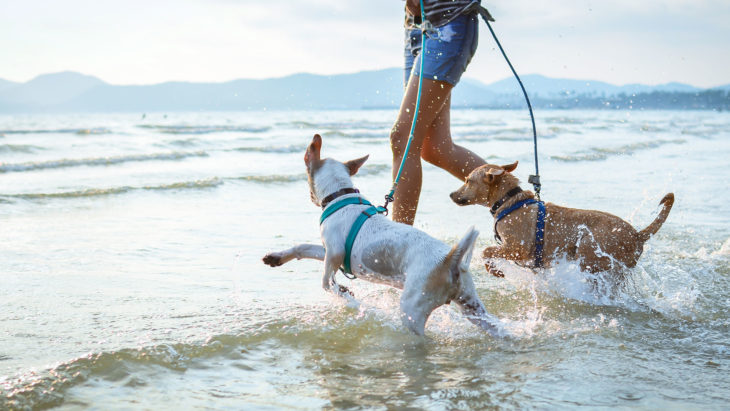
Source: campingsanbenedetto
Introduction aside, we need first to discuss your dog’s personality. Camping might not be suitable for all dogs, and it doesn’t have to do with their size or breed. Every dog has a different nature, and this can determine whether they would be suitable to take with. You can also gain a lot of knowledge about various hacks to follow to make your expedition even more exciting.
They might be a perfect candidate, or they might end up ruining your (and surrounding peoples) trip. Therefore, consider the following traits and come up with an honest assessment of your dog falls within them:
1. Does your dog always bark? Most likely, nobody wants to be woken up by a fellow camper’s dog early in the morning. We get it, they’re dogs, and they like to bark, but if your pet has a particular fondness of voicing his opinion frequently, you may need to adjust your trip. It doesn’t mean you cannot take them camping; you’ll have to find a campsite that’s very large and possibly away from neighboring guests.
2. Is your dog obedient when you call him? If your dog doesn’t come when it is called, there may be a problem. You wouldn’t want to lose your little friend out there in the wilderness. You can place him on a leash, but that would require your continual guidance, which can take away from the ‘freedom’ they’d prefer otherwise.
3. How does your dog interact with others? A significant factor when taking your dog out is that it has been socialized correctly. Campsites are filled with children and other dogs, which may not be the best of ideas if your dog is known for being a little protective or aggressive towards others. Again, your dog can be placed on a leash, and a muzzle can be placed on its mouth, but in this case, maybe the wilderness or forest would suit your dog better.
4. Does your dog like being on a leash? As stated above, to accommodate your dog, they might need to be placed on a leash. If they don’t like it, and they’re placed in it for a few days, there might be a severe problem. Again, you could change your location to better suit your dog, so a no leash preference isn’t the end of the world.
5. A tendency to steal food? It might be amusing at home when your dog runs away with the leftovers on your plate, but not so much when it’s the neighbor’s food on the campfire. While camping, food will not be stored in fridges, and it’s likely to be out in the open. If your doggo loves human food and hasn’t been trained to wait for their own, he could be eating the neighbor’s hot dogs when nobody is looking. Always get him on a leash or supervise the food if this is the case.
What Are Your Camping Plans?
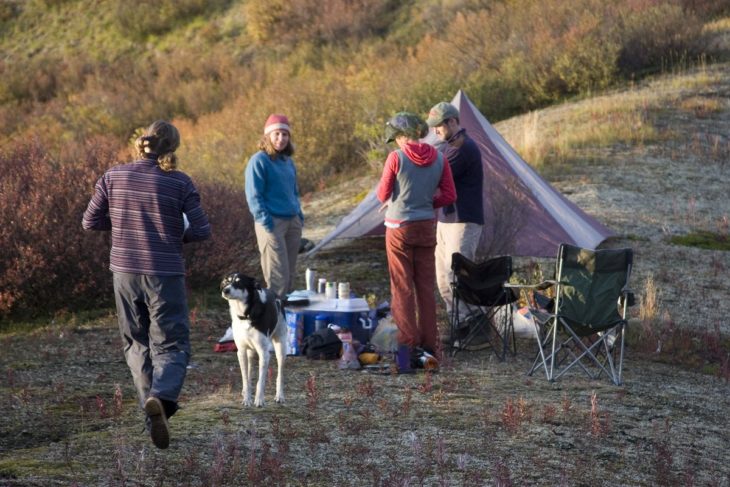
Source: twitter
You need to ask yourself what you’ll be getting up to this trip before you leave. If you plan to head into tourist attractions and towns, bringing your pet along probably won’t be ideal. Most likely, you’ll have to leave him behind at the campsite on a leash, and that’s a disaster waiting to happen. You wouldn’t leave them in a car, would you? The same principle applies.
An ideal situation would involve staying in the outdoors and exploring nature. This way, your dog can always tag along and be with you. We’re not saying take your dog everywhere you go, they can be on a leash or wander off and do their own thing, but rather leave them at home if you’re planning to go shopping all day. The very premise of camping was to get out of the city or away from everyday life.
Be Prepared Before You Depart for Your Trip
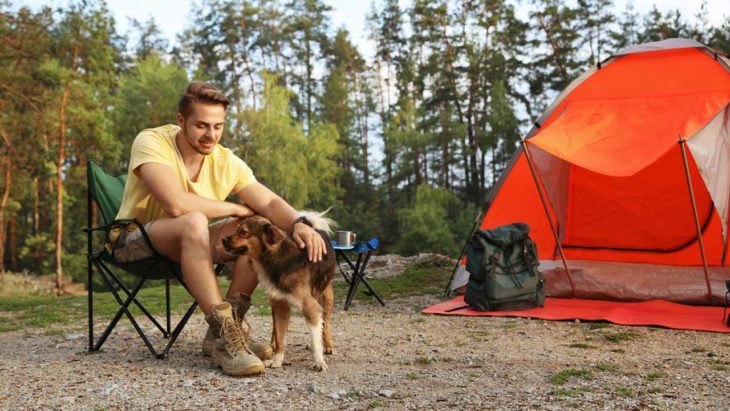
Source: bestinau
1. Choose the correct camping location: most campsites might have specific rules and regulations towards pets. Make sure you do your research and know the possible additional fees involved. National parks and forests usually don’t have any restrictions on them, and it’s often the safest bet.
2. Know where the vet is: anything can happen, so know emergency numbers. If your pet gets injured, you should know where to go, just in case.
3. Have a first aid kit ready: be prepared for smaller injuries, there are thorns and sharp objects on the ground, and your little friend’s paws might be vulnerable. Pack in a first aid kit, so you’re equipped for the boo-boos.
4. Tick and flea preventative: apply a spray to your dog, so it doesn’t pick up any parasites during your trip. Remember, once you return home, these parasites may spread throughout your house and cause even more trouble.
5. Tag your dog: It’s a good idea to have identification on your dog. That way, if it somehow got lost or anything goes wrong, the person who finds him will know who to call.
Unwritten Rules While Camping with Your Dog
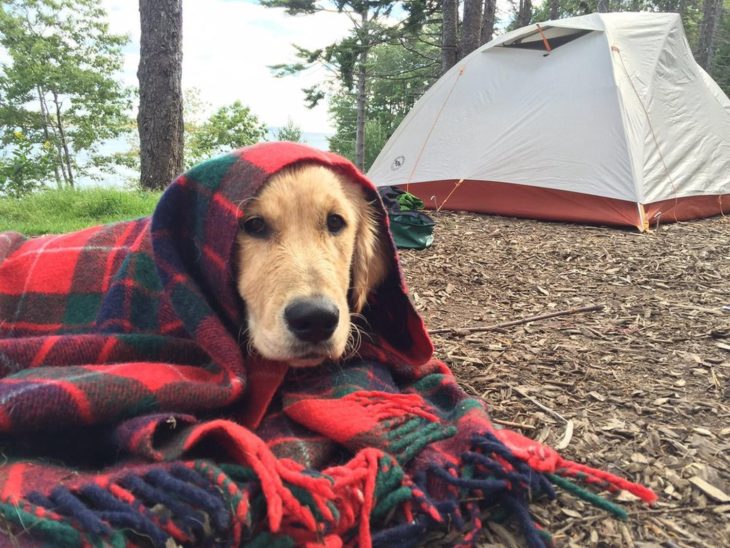
Source: medium
We previously mentioned that most campsites have their own rules regarding dogs. They may include: keeping them on a leash at all times, don’t leave them unattended and keep them away from children. However, as dog owners, there are some rules which are instilled in most of us that we should all apply.
1. Pick up your dog’s poop: You may think you’re outdoors, and this isn’t the city, but be considerate. If you’re at the campsite, guests will be walking around, and nobody wants to have a light night surprise on their way to the bathroom.
2. Don’t ignore the barking: Maybe he doesn’t often bark, do you think he will eventually stop. That shouldn’t be the case; however, attend to your dog and take them for a walk. Other camp residents might find the barking annoying, so it’s your responsibility to deal with it.
3. Tell people your dog is friendly: Most people might get a bit scared when more giant dog approaches. Many won’t assume your pet is a big ball of cuddly fur. It’s a good idea to say to people that your dog means no harm if they cross paths with you.
4. Don’t let your dog get too friendly with the locals: Maybe they’re polite, but don’t let your dog spend too much time around other people’s campsites. They might be tolerating him out of courtesy, but you shouldn’t use it as an opportunity to shift your responsibilities.
Food and Shelter
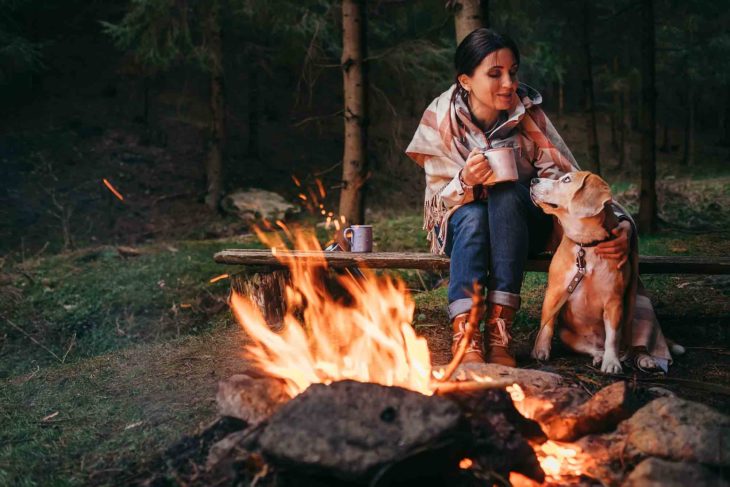
Source: summeridgeanimalclinic
Your dog is likely to burn a lot of calories running more and adventuring with you. It’s a good idea to pack more food and possibly feed your pet more, so they don’t get hungry. Remember, you wouldn’t want your dog visiting fellow campers and running off with their supper.
Finally, where is your dog going to sleep? Make sure they are secured to a leash at night if you plan to leave them outside. If you prefer sleeping beside them, even better! There are various dog tents, beds, and mats you can consider buying to find a comfortable situation for them.
Have Fun
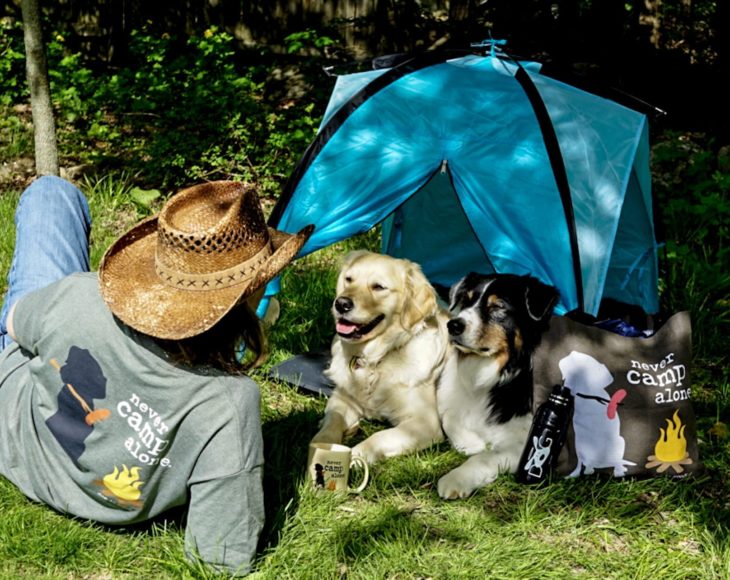
Source: dogisgood
Camping with your dog can be a memorable experience. There will be some “oh no” moments if you`re a first-time dog camper, but this shouldn’t discourage you. If you apply the tips from this article correctly, you should be well prepared for anything. Relax and have a good time with your dog, they will surely make everything more thrilling while you’re out there.
Pack your camera and get ready for those extra likes on Instagram from fellow dog lovers!
